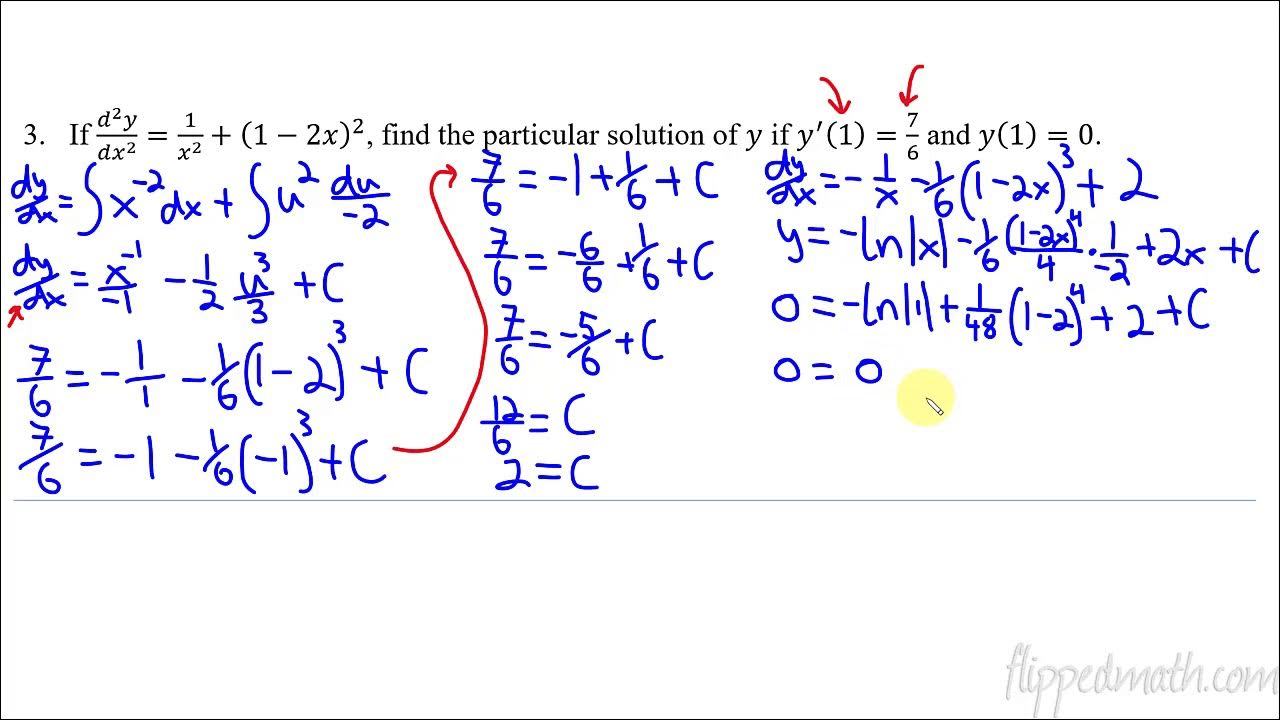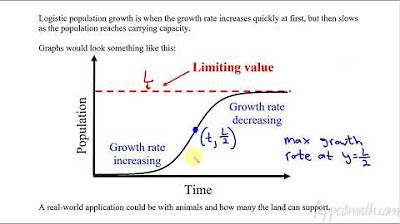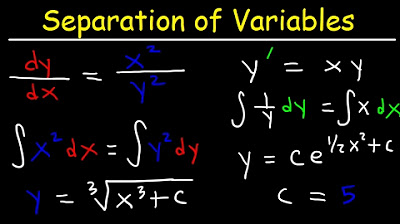Calculus AB/BC – 7.7 Particular Solutions using Initial Conditions and Separation of Variables
TLDRIn this educational video, Mr. Bean presents a lesson on solving differential equations using the method of separation of variables. The video focuses on finding particular solutions to differential equations that pass through a given point. Mr. Bean simplifies the equations and guides viewers through the integration process, emphasizing the importance of determining unknown constants. He demonstrates how to apply initial conditions to find the exact solution and discusses the significance of graphing these solutions to understand their behavior. The video also covers the challenges of dealing with absolute values and asymptotes in the solutions, providing insights into how to choose the correct solution based on the given conditions. Mr. Bean's approach is engaging, with a mix of humor and practical examples that make the complex subject matter more accessible to learners.
Takeaways
- 📚 In this lesson, Mr. Bean teaches how to solve differential equations using separation of variables and finding particular solutions through a given point.
- 🔍 The process involves simplifying the differential equation into a form where variables can be separated and then integrating both sides.
- ✍️ After integrating, a decision is made whether to plug in a point to find the constant or solve for y first; both methods yield the same result.
- 🔢 The constant of integration is found by substituting a given point into the integrated equation and solving for the constant.
- 🎯 For the first example, the solution is obtained by integrating and then solving for y, which involves algebraic manipulation to express y in terms of x.
- 📈 The graph of the first solution is described as having an asymptote and flattening out as x approaches negative infinity.
- 🧮 In the second example, the solution involves squaring both sides of the equation, which introduces a plus or minus scenario that must be resolved using the given point.
- 📊 The graph of the second solution is a hyperbola, and the correct side to graph is determined by the given point's position.
- 🔗 The third example deals with the natural logarithm and exponential functions, leading to an absolute value that must be resolved into a plus or minus form.
- ➗ Removing the absolute value involves creating two separate equations, which are solved to find the correct form of the solution.
- 📉 The slope field in the third example helps to visualize whether the solution lies above or below the asymptote, aiding in choosing the correct sign for the solution.
- 📚 The lesson concludes with a reminder that practice and understanding the process are key to mastering the solution of differential equations.
Q & A
What is the differential equation that Mr. Bean is solving in the first part of the lesson?
-The differential equation Mr. Bean is solving is dy/dx = x^2 * y^2.
How does Mr. Bean simplify the differential equation to separate the variables?
-Mr. Bean simplifies the differential equation by dividing both sides by y^2, resulting in (1/y^2)dy = x^2 dx.
What is the integral form of the separated differential equation?
-The integral form is y^(-1) = (1/3)x^3 + C, where C is an unknown constant.
How does Mr. Bean determine the value of the constant C?
-Mr. Bean determines the value of C by plugging in the point (1,1) into the equation, which gives him -1/1 = (1/3)(1)^3 + C, leading to C = -4/3.
What is the final form of the solution for the first differential equation?
-The final form of the solution is 1/y = (1/3)x^3 - 4/3, which can be rearranged to y = 3 / (x^3 - 4/3).
What is the second differential equation Mr. Bean works on, and how does he separate the variables?
-The second differential equation is dy = 2x dx, and he separates the variables by dividing both sides by 2x, resulting in (1/2)y^2 = x^2 + C.
How does Mr. Bean handle the constant after multiplying both sides of the second equation by 2?
-After multiplying both sides by 2, Mr. Bean gets y^2 = 2x^2 + C', where C' is a new constant that is different from the previous one.
What is the method used to find the second constant in the second differential equation?
-Mr. Bean uses the initial condition (x, y) = (2, 1) to find the second constant, which results in 1^2 = 2*(2^2) + C', leading to C' = -7.
What is the final solution for the second differential equation, and how does Mr. Bean determine the correct sign for y?
-The final solution is y = ±√(2x^2 - 7). Mr. Bean determines that the correct sign for y is positive because the point (2, 1) must satisfy the equation, and 1 is a positive number.
What is the third differential equation Mr. Bean solves, and how does he approach the integration?
-The third differential equation is 1/(y+2) dy = e^x dx. Mr. Bean integrates both sides to get ln|y+2| = e^x + C, where C is the constant of integration.
How does Mr. Bean deal with the absolute value in the final expression of the third differential equation?
-Mr. Bean deals with the absolute value by considering both the positive and negative possibilities, which leads to y = ±e^(e^x - 1) - 2. He then uses the initial condition to determine the correct sign.
What is the final solution for the third differential equation after considering the initial condition?
-The final solution is y = e^(e^x - 1) - 2, with the positive sign chosen based on the initial condition.
Outlines
📚 Introduction to Solving Differential Equations with Separation of Variables
The video begins with Mr. Bean introducing the topic of solving differential equations using the method of separation of variables. The focus is on finding both the general solution and the particular solution that passes through a given point. The process involves simplifying the differential equation and integrating both sides to find the solution. An example is worked through, starting with the equation dy/dx = x^2 * y^2, which is simplified and solved to find y in terms of x and a constant. The constant is then determined by plugging in a given point, and the final solution is expressed in terms of x.
🔍 Choosing the Correct Square Root for a Solution Passing Through a Point
The second paragraph deals with solving a differential equation and determining which of the two possible square roots to choose for the solution that passes through a specific point (2,1). The equation y^2 = 2x^2 + C is used, and by substituting the given point, the constant C is found to be -7. The choice between the positive and negative square roots is resolved by considering the nature of the point given and the resulting graph, which is a branch of a hyperbola. The explanation emphasizes the importance of using the graph to understand which part of the hyperbola corresponds to the solution.
🧮 Dealing with Absolute Values and Asymptotes in Differential Equations
The third paragraph discusses the solution to a differential equation involving an absolute value, which is transformed into two separate equations due to the plus or minus nature of square roots. The equation involves the natural logarithm and exponential functions, leading to an expression involving e^(e^x). The challenge lies in determining the correct form after removing the absolute value, which is resolved by substituting a given point into the potential solutions. The paragraph also touches on the use of slope fields to visualize and understand the behavior of the solution, particularly in relation to asymptotes.
Mindmap
Keywords
💡Differential Equations
💡Separation of Variables
💡Exact Solution
💡Particular Solution
💡Integration
💡Unknown Constant
💡Asymptote
💡Graph
💡Initial Condition
💡Slope Field
💡Absolute Value
Highlights
The lesson focuses on solving differential equations using separation of variables to find the exact solution through a given point.
The differential equation dy/dx = x^2 * y^2 is solved by separating variables and integrating both sides.
The general solution is obtained as y^(-1) = (1/3) * x^3 + C, where C is an unknown constant.
The constant C is determined by plugging in the initial condition (1,1) into the general solution.
The final particular solution is y = 1/((3/x^3) + 4/3) after finding the value of C.
The graph of the solution has an asymptote at x=0 and approaches zero as x goes to negative infinity.
In the next example, the differential equation dy = 2x dx is solved with initial condition (2,1).
The general solution is y^2 = 2x^2 + C, and the constant C is found to be -7 using the initial condition.
The final particular solution is y = ±√(2x^2 - 7). The positive square root is chosen based on the initial condition.
The graph of the solution is a branch of a hyperbola that flattens out and approaches infinity.
In the third example, the differential equation (1/(y+2)) dy = e^x dx is solved.
The general solution is ln|y+2| = e^x + C, where C is found to be -1 using the initial condition (0,-1).
The final particular solution is y = ±e^(e^x - 1) - 2. The positive value is chosen based on the slope field.
The slope field helps determine which branch of the solution to graph based on the initial condition.
Absolute value equations become two separate equations when solved, with a plus or minus.
The lesson covers some challenging problems to prepare students for more difficult exam questions.
The key takeaway is to be comfortable solving differential equations using separation of variables and finding particular solutions.
Transcripts
Browse More Related Video

Calculus AB/BC – 7.2 Verifying Solutions for Differential Equations

Calculus BC – 7.9 Logistic Models with Differential Equations

AP Calculus AB: Lesson 7.2 Slope Fields

Separation of Variables

Separable First Order Differential Equations - Basic Introduction

Business Calculus - Math 1329 - Section 5.1 - Indefinite Integration & Differential Equations
5.0 / 5 (0 votes)
Thanks for rating: